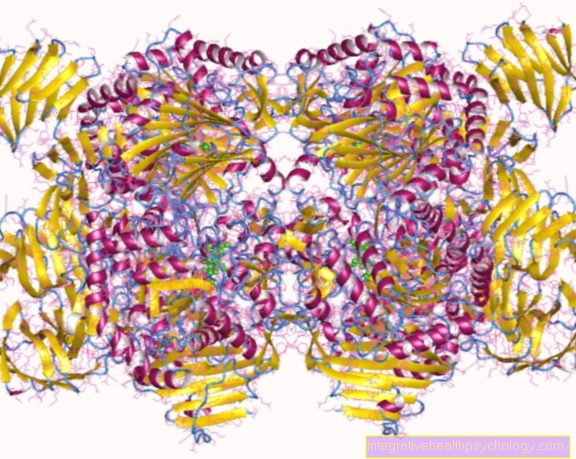Lipoma on the spine
General
Lipomas are benign soft tissue tumors that arise from fat cells and are particularly common on the neck, on the spine, and on the thighs and lower legs.
Most lipomas grow directly under the skin, so they are quickly visible from the outside and appear as small lumps or nodules. Since many lipomas are painful above a certain size, it is advisable to remove them surgically.

definition
Lipomas are slowly growing, harmless neoplasms of the soft tissue (benign soft tissue tumor), which arise from mature fat cells and are therefore also referred to as fatty tumors.
Most lipomas are encased in a connective tissue capsule and are located subcutaneously, i.e. directly under the skin. They are particularly common on the spine, neck, arms and legs.
Men over 30 are more likely to be affected than women. Children are affected even less often. Different types of lipoma on the spine include the muscular lipoma, the subfascial lipoma and the angiolipoma.
The former are found particularly often on the sacrum and lumbar spine or on the head between the forehead and hairline.
Angiolipomas are mostly found in very young men, grow under the muscles and are riddled with thrombosed blood vessels.
Spindle cell lipomas are another type of lipoma and are often found on the spine or shoulders of men between the ages of 45 and 60.
Compared to angiolipomas, which are always painful, spindle cell lipomas usually do not cause any symptoms.
If the affected person has a lot of lipomas at the same time, this is called lipomatosis (see also: Epidural lipomatosis), a disease with an increased tendency to lipomas.
root cause
The exact causes of lipomas are still unknown. But researchers assume that in addition to genetic Factors too increased blood lipids play a role in the development of lipoma. Especially metabolic diseases like diabetes or gout can increase the risk of lipomas and lipomatosis (so many lipomas) accompanied.
Symptoms
The lipoma usually manifests itself as a more elastic, rubbery and good more flexible Bumps on the spine or arms and legs.
They are usually skin-colored and are up to a few centimeters in size.
However, if you let them grow for a long time, from a certain size onwards there will be one Compression of the nerves and Blood vessels. This in turn expresses itself in the form of Numbness (Paresthesia) and Pressure pain.
Diagnosis
Since every newly appeared mass on the skin has to be examined and clarified by a doctor, a new lipoma should also be shown to a doctor.
This can usually tell by looking and touching whether it is a harmless lipoma, one cyst, a Fibroma or something Malicious acts.
When touching, the doctor pays attention to the elasticity of the knot, its mobility and its consistency. Can a Ultrasonic carried out, whereby cysts or malignant changes can be excluded.
If a malignant neoplasm (e.g. a Liposarcoma) exist, a small one follows first Tissue extraction (biopsy), which is then examined under the microscope, and then a X-ray image and a Computed Tomography.
therapy
Most lipomas must per se not removed become.
But since lipomas on the spine, neck or flanks are often exposed to pressure from clothes or while sleeping, they can be painful and stressful for those affected.
Here one is recommended surgical removal of the lipoma.
This procedure usually takes place under one local anesthesia and only takes a few minutes. With the help of a scalpel, the surgeon makes a small incision through which the lipoma and capsule are pushed out. In the case of very large or multiple lipomas, they are removed in general anesthetic.
Lipomas located subfascial or in the muscle are also usually operated under general anesthesia, as they are surgical Exposure of the muscle require before the lipoma can be removed.
This operation usually goes well with a larger one scar hand in hand.
As with any procedure, the removal of a lipoma on the spine has complications such as Secondary bleeding, Infections or Wound healing disorders be expected. However, since the wound is usually only very small and a long hospital stay is not necessary, these risks are negligible.
Another option for treating lipoma is this Liposuction (Liposuction). This operation is usually carried out under a special local anesthetic, which also includes a Liquefaction of adipose tissue causes.
The surgeon then makes a small incision through which a cannula is inserted, with which the now liquid fat from the lipoma can be sucked off. The advantages of this treatment are its minimally large incisions, the resulting smaller and finer scars and less post-operative pain. The main disadvantage of this method, however, is that the lipomas not completely removed so often residues are left behind.
These can then grow into a new lipoma over time.
For this reason, conventional surgical removal of the lipoma (by means of extirpation), preferable to liposuction.
Another option for treating lipoma is this Liposuction (Liposuction). This operation is usually carried out under a special local anesthetic, which also includes a Liquefaction of adipose tissue causes.
The surgeon then makes a small incision through which a cannula is inserted, with which the now liquid fat from the lipoma can be sucked off. The advantages of this treatment are its minimally large incisions, the resulting smaller and finer scars and less post-operative pain. The main disadvantage of this method, however, is that the lipomas not completely removed so often residues are left behind.
These can then grow into a new lipoma over time.
For this reason, conventional surgical removal of the lipoma (by means of extirpation), preferable to liposuction.
forecast
Lipomas tend to be often to relapses, which is why repeated surgery per se is often necessary.
Since liposuction also promotes this new formation of lipomas due to their incomplete removal, a operational renovation liposuction always preferred become.
Nevertheless, lipomas have a very good prognosis, as they rarely change into a malignant form and thus remain harmless well treatable are.





























